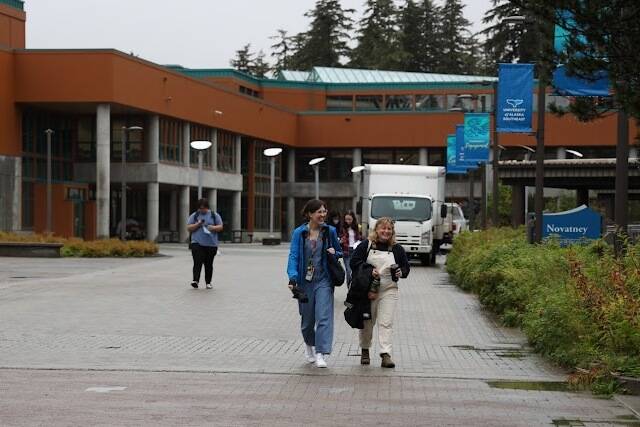Students donned raincoats and Xtratufs Monday morning as they walked through the rain to their first day of classes for the fall semester at the University of Alaska Southeast campus in Juneau.
“We’ve had a lot of activity this morning even in the pouring rain,” Lori Klein, the vice chancellor of enrollment management and student affairs at the University of Alaska Southeast. “It’s always a really exciting time of year to welcome new students to our university community and welcome returning students back.”
This year UAS welcomed 150 students at its new student orientation, held this past weekend. That is a higher turnout than last year’s orientation, Klein said. She said the actual amount of new students is likely to be upward of 2oo, which is inline with other campuses in the UA system, which are also seeing a rise in new students compared to the previous academic year. According to data collected by the university, the combined collective headcount of UA students is up 3% compared to this time last year, and the overall new student enrollment numbers are up 13% from last year as well.
At UAS, the students were welcomed with free coffee, treats and a chance to tye-dye a shirt or socks at multiple tents set up courtesy of UAS employees who volunteered to welcome the students on the first day. Klein said there will be multiple events throughout the week to celebrate the start of the new semester.
For many returning students, there is another reason to celebrate as Monday also marked the first day back to classes after President Joe Biden announced his plan to provide $10,000 in student debt cancellation for students across the country and even larger cancellations for people in the greatest financial need.
[How will the student loan forgiveness plan impact Alaskans?]
According to data from the Integrated Postsecondary Education Data System, 16% of UAS undergraduate students took out student loans which averaged $6,410 during the 2019-2020 school year (the 2020-2021 information has yet to be released), and an April 2022 study by the Educational Data Initiative found more than 65,000 Alaska residents are currently living with student loans and just under 50% of them are 35 years old or younger.
Overall, that equates to 9.2% of the state’s residents having some type of student loan debt and more than 80% were found to have at least $5,000 in debt to repay.
Kylli Anderson, a senior studying wildlife and conservation biology who recently decided to transfer to UAS from the University of Minnesota, said she was relieved when she heard the news of the student loan forgiveness. She said she recently took out another loan before starting school at UAS and said the plan will take some weight off her shoulders, although she said she hopes there’s more to come.
“It does help a lot — but I wish it was bigger,” she said. “It’s only federal loans and I have more loans than that.”
Sophia Coleman, a freshman from Wasilla studying special education, said she was happy to hear the news that people would be getting help even though as a new student she would not be getting any of the relief.
“I’m very happy for the people who did get it even if I didn’t benefit from it,” she said.
Coleman and Anderson, who sat among four other new UAS students in the school’s cafeteria on Monday morning, said they don’t know what the future of student loans looks like now that the president has opened the door to loan forgiveness as a possibility, but said all said they hope that they will also get a chance to receive similar benefits in the future.
University of Alaska President Pat Pitney previously told the Empire in a statement that she welcomes the news of loan forgiveness as it will aid the many students who borrow to pay for college at UA and said the school will continue to work toward making college more affordable across the state.
“UA strives to make college more affordable and limit student debt through our many scholarship programs including the UA Scholars program, and why we support the Alaska Performance Scholarship, WWAMI and student grant programs,” she said. “Alaskans should explore educational opportunities through UA programs for teachers, engineers, accountants, and the variety of technical programs we offer to meet Alaska’s workforce shortages. Given these shortages, now may be the time to restart the state’s student loan forgiveness program like the process used in the late 1970’s and 1980’s when we saw similar workforce shortages. I think now is the time to restart the program to keep our best and brightest in state.”
Biden is expected to share more information on the plan in the coming weeks, according to the White House.
• Contact reporter Clarise Larson at clarise.larson@juneauempire.com or (651)-528-1807. Follow her on Twitter at @clariselarson.

